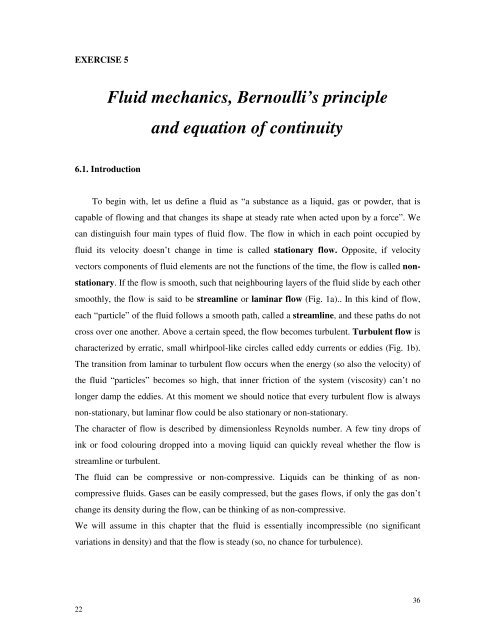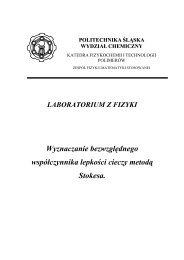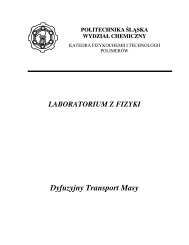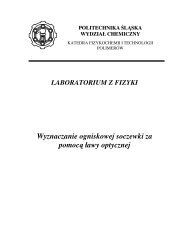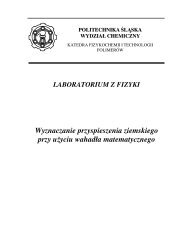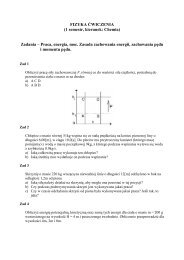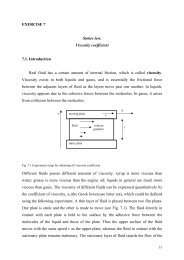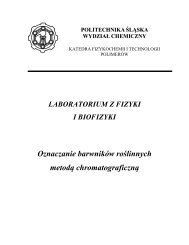Fluid mechanics, Bernoulli's principle and equation of continuity
Fluid mechanics, Bernoulli's principle and equation of continuity
Fluid mechanics, Bernoulli's principle and equation of continuity
Create successful ePaper yourself
Turn your PDF publications into a flip-book with our unique Google optimized e-Paper software.
EXERCISE 5<br />
<strong>Fluid</strong> <strong>mechanics</strong>, Bernoulli’s <strong>principle</strong><br />
<strong>and</strong> <strong>equation</strong> <strong>of</strong> <strong>continuity</strong><br />
6.1. Introduction<br />
To begin with, let us define a fluid as “a substance as a liquid, gas or powder, that is<br />
capable <strong>of</strong> flowing <strong>and</strong> that changes its shape at steady rate when acted upon by a force”. We<br />
can distinguish four main types <strong>of</strong> fluid flow. The flow in which in each point occupied by<br />
fluid its velocity doesn’t change in time is called stationary flow. Opposite, if velocity<br />
vectors components <strong>of</strong> fluid elements are not the functions <strong>of</strong> the time, the flow is called nonstationary.<br />
If the flow is smooth, such that neighbouring layers <strong>of</strong> the fluid slide by each other<br />
smoothly, the flow is said to be streamline or laminar flow (Fig. 1a).. In this kind <strong>of</strong> flow,<br />
each “particle” <strong>of</strong> the fluid follows a smooth path, called a streamline, <strong>and</strong> these paths do not<br />
cross over one another. Above a certain speed, the flow becomes turbulent. Turbulent flow is<br />
characterized by erratic, small whirlpool-like circles called eddy currents or eddies (Fig. 1b).<br />
The transition from laminar to turbulent flow occurs when the energy (so also the velocity) <strong>of</strong><br />
the fluid “particles” becomes so high, that inner friction <strong>of</strong> the system (viscosity) can’t no<br />
longer damp the eddies. At this moment we should notice that every turbulent flow is always<br />
non-stationary, but laminar flow could be also stationary or non-stationary.<br />
The character <strong>of</strong> flow is described by dimensionless Reynolds number. A few tiny drops <strong>of</strong><br />
ink or food colouring dropped into a moving liquid can quickly reveal whether the flow is<br />
streamline or turbulent.<br />
The fluid can be compressive or non-compressive. Liquids can be thinking <strong>of</strong> as noncompressive<br />
fluids. Gases can be easily compressed, but the gases flows, if only the gas don’t<br />
change its density during the flow, can be thinking <strong>of</strong> as non-compressive.<br />
We will assume in this chapter that the fluid is essentially incompressible (no significant<br />
variations in density) <strong>and</strong> that the flow is steady (so, no chance for turbulence).<br />
22<br />
36
FLUID MECHANICS. BERNOULLI’S PRINCIPLE AND EQUATION OF CONTINUITY<br />
Fig. 1 (a) Streamline or laminar flow; (b) turbulent flow.<br />
Let us consider the steady (laminar) flow <strong>of</strong> fluid through an enclosed tube or pipe as shown<br />
in Fig. 6.2.<br />
Fig. 6.2. <strong>Fluid</strong> flow through a pipe <strong>of</strong> varying diameter.<br />
In such a pipe, the mass must be conserved, e.g. if we put mass m 1 into the pipe, then the same<br />
mass m 2 =m 1 must flow out <strong>of</strong> this pipe (provided, the fluid is incompressible, since otherwise<br />
the pipe can accumulate some mass, with no outgoing flow).<br />
Consider infinitely small portion <strong>of</strong> mass, dm, put in a time dt into the pipe. From mass<br />
conservation, we write”<br />
dm<br />
1<br />
= dm 2<br />
(6.1)<br />
Knowing the relation <strong>of</strong> mass to volume <strong>and</strong> density, this reveals:<br />
37
FLUID MECHANICS. BERNOULLI’S PRINCIPLE AND EQUATION OF CONTINUITY<br />
dV<br />
1ρ = dV2ρ<br />
(6.2)<br />
Volume, that falls into the pipe in a time dt is equal V=Adx, where A is the area <strong>of</strong> crosssection<br />
<strong>of</strong> the pipe, <strong>and</strong> dx is the thickness <strong>of</strong> the mass layer, pumped in time dt. Substituting<br />
this to above <strong>equation</strong>, keeping in mind the definition <strong>of</strong> velocity, we have<br />
A dx<br />
1<br />
A v<br />
1<br />
1<br />
1<br />
= A<br />
= A<br />
2<br />
2<br />
v<br />
dx<br />
2<br />
2<br />
/ dt<br />
(6.3)<br />
This is the <strong>continuity</strong> <strong>equation</strong> for a fluid.<br />
Equation (6.3) tells us that where the cross-sectional area is large the velocity is small, <strong>and</strong><br />
where the area is small the velocity is large. That this is reasonable <strong>and</strong> can be observed by<br />
looking at a river. A river flows slowly through a meadow where it is broad, but speeds up to<br />
torrential speed when passing through a narrow gorge. Have you ever wondered why smoke<br />
goes up a chimney, why a car’s convertible top bulges upward at high speeds or how a<br />
sailboat can move against the wind? There are examples <strong>of</strong> a <strong>principle</strong> worked out by Daniel<br />
Bernoulli (1700-1782) in the early eighteenth century. In essence, Bernoulli’s <strong>principle</strong> states<br />
that where the velocity <strong>of</strong> a fluid is high, the pressure is low.<br />
Fig. 6.3 <strong>Fluid</strong> flow: for derivation <strong>of</strong> Bernoulli’s <strong>equation</strong>.<br />
38
FLUID MECHANICS. BERNOULLI’S PRINCIPLE AND EQUATION OF CONTINUITY<br />
Bernoulli developed an <strong>equation</strong> that expresses this <strong>principle</strong> quantitatively. To derive<br />
Bernoulli’s <strong>equation</strong>, we assume the flow is steady <strong>and</strong> laminar the fluid is incompressible,<br />
<strong>and</strong> the viscosity is small enough to be ignored. To be general, we assume the fluid is flowing<br />
in a tube <strong>of</strong> nonuniform cross section that varies in height above some reference level, Fig 6.3.<br />
Bernoulli’s <strong>equation</strong> in such system is simply an expression <strong>of</strong> the work-energy theorem.<br />
What is the energy <strong>of</strong> the fluid at some position in the pipe? It is a sum <strong>of</strong> kinetic energy,<br />
potential gravitational energy, <strong>and</strong> internal energy, put by external force. For a mass element<br />
dm=ρAdx, we can write this as<br />
E = E + E + E<br />
(6.4.)<br />
K<br />
P<br />
i<br />
2<br />
dmv<br />
E<br />
K<br />
= (6.5.)<br />
2<br />
E P<br />
= dmgh<br />
(6.6.)<br />
E i<br />
= pdV<br />
(6.7.)<br />
The energy components have self-explanatory meaning, kinetic energy is defined as usual,<br />
gravitational potential energy also. A comment needs only be done on the internal energy. To<br />
put the mass element dm into the pipe, we have to overcome some pressure p, which exists in<br />
that pipe. This pressure generates a force F = pA that resists the motion. Moving by dx, a<br />
work needs to be done on the fluid,<br />
W = Fdx = pAdx = pdV . This work changes to the<br />
internal energy <strong>of</strong> the fluid.<br />
We can divide the energy <strong>equation</strong> (6.4) by dV to obtain the Bernoulli <strong>equation</strong>, which states,<br />
that the energy <strong>of</strong> a fluid doesn’t change in the flow. This is reasonable, since no energy is put<br />
to the fluid anywhere else, than in its input. Thus we have, keeping in mind that dm=ρdV, that<br />
1 2<br />
P + ρv<br />
+ ρgy<br />
= constant<br />
(6.8)<br />
2<br />
39
FLUID MECHANICS. BERNOULLI’S PRINCIPLE AND EQUATION OF CONTINUITY<br />
or equivalently, taking two points in the pipe <strong>and</strong> evaluating above <strong>equation</strong> for both <strong>of</strong> them,<br />
1 2<br />
1 2<br />
P1 + ρv1<br />
+ ρgy1<br />
= P2<br />
+ ρv<br />
2<br />
+ ρgy<br />
2<br />
(6.9)<br />
2<br />
2<br />
This is Bernoulli’s <strong>equation</strong>. [if there is no flow (v 1 =v 2 =0), then eq. (6.9) reduces to the<br />
hydrostatic <strong>equation</strong>: P 2 -P 1 =-ρg(y 2 -y 1 ).]<br />
6.2. Measurements<br />
Experimental setup is shown on the figure below:<br />
Fig. 6.4. Experimental setup.<br />
The experimental setup consists <strong>of</strong> pomp, which pumps the water from container A, through<br />
glass pipe with two different cross-section areas to container B. In order to avoid high<br />
40
FLUID MECHANICS. BERNOULLI’S PRINCIPLE AND EQUATION OF CONTINUITY<br />
pressure increase in the system when the pump is turn on with valve nr.1 closed, a part <strong>of</strong><br />
water goes back to container A. There are two valves in the system: earlier mentioned one<br />
(nr.1), which allows us to control water flow rate in the system (it should always be closed<br />
when you turn on the pump) <strong>and</strong> valve nr.2 (it should be always open).<br />
In two part <strong>of</strong> the glass pipe – in wide <strong>and</strong> in narrow – pressure, manometric tubes are used to<br />
measure the static pressure in the system. Such kind <strong>of</strong> measurements doesn’t disturb the<br />
water flow in the glass pipe. Bernoulli’s law says that the pressure will be different in these<br />
two points <strong>of</strong> glass pipe. If two manometric tubes will be connected as it is shown on the<br />
fig.6.4, we obtain manometric tube <strong>and</strong> the observed difference <strong>of</strong> the liquid level, will be<br />
equal to the difference <strong>of</strong> static pressure between two points in the pipe. The knowledge <strong>of</strong><br />
pressure difference p 1 –p 2 isn’t enough to determine the rate flow <strong>of</strong> the water. We need to<br />
assume the flow <strong>continuity</strong> <strong>and</strong> we need to know the cross-section areas A 1 <strong>and</strong> A 2<br />
To begin with you have to measure the diameter <strong>of</strong> two cross sections (1 <strong>and</strong> 2, see the Fig.<br />
6.4) <strong>of</strong> the pipe <strong>and</strong> calculate the cross-sections areas A 1 <strong>and</strong> A 2. .<br />
Next you should prepare the system to perform the experiment.<br />
Attention!!!<br />
Before you turn on the pump, be sure that the valve nr.2 is open (the arm should be parallel in<br />
respect to the hose) <strong>and</strong> valve nr.1 is closed (the arm should be perpendicular in respect to the<br />
hose). Be also sure that the container A is filled with water, the container B is empty <strong>and</strong> that<br />
all connections are ok (see the scheme).<br />
Never turn on the pump without checking valves configurations <strong>and</strong> hoses connections!!!!<br />
The experiment:<br />
• Before each measurement, note the initial difference <strong>of</strong> liquid level in manometric<br />
tube. (it should be not greater than 15mm)<br />
• After checking <strong>of</strong> valves configurations <strong>and</strong> connections turn on the pump.<br />
41
FLUID MECHANICS. BERNOULLI’S PRINCIPLE AND EQUATION OF CONTINUITY<br />
• The measurements should be de tree times, for tree different open degree <strong>of</strong> valve nr.1.<br />
• After valve nr.1 opening, you should notice times needed to fill the container B with<br />
the water volumes equal to 5L, 10L <strong>and</strong> 15L.<br />
• In the same time, note the liquid level difference in the manometric tube ∆h for given<br />
volume.<br />
• After finishing <strong>of</strong> measurements, very slowly close the valve nr.1 <strong>and</strong> then turn <strong>of</strong>f the<br />
pump (exactly in the specified order).<br />
• After finishing <strong>of</strong> given measurement, you should pour the water from container B to<br />
container A <strong>and</strong> repeated the measurements for another valve nr.1 open degree.<br />
Attention!!!<br />
The container A should always be filled with water to marked minimum level. If the water<br />
level in container A reaches its minimum, you should instantly turn <strong>of</strong>f the pump.<br />
Calculations:<br />
From <strong>equation</strong> <strong>of</strong> <strong>continuity</strong> <strong>and</strong> Bernoulli’s <strong>equation</strong> we can express the velocity at cross<br />
section 2 as:<br />
v = (6.10)<br />
1A1<br />
v<br />
2A<br />
2<br />
A<br />
2<br />
v<br />
1<br />
= v<br />
2<br />
(6.11)<br />
A1<br />
p<br />
2<br />
2<br />
v1<br />
v<br />
2<br />
+ ρ<br />
w<br />
= p<br />
2<br />
+<br />
w<br />
(6.12)<br />
2<br />
2<br />
1<br />
ρ<br />
p<br />
2 2<br />
2<br />
v<br />
2A<br />
2<br />
v<br />
2<br />
+ ρ<br />
w<br />
= p<br />
2 2<br />
+<br />
w<br />
(6.13)<br />
2A<br />
2<br />
1<br />
ρ<br />
1<br />
2<br />
− 2∆pA<br />
v = (6.14)<br />
ρ<br />
2<br />
w<br />
1<br />
2 2<br />
( A − A )<br />
1<br />
2<br />
42
FLUID MECHANICS. BERNOULLI’S PRINCIPLE AND EQUATION OF CONTINUITY<br />
where ∆p is the pressure difference between cross-sections A2 i A1:<br />
-∆p = -(p 2 -p 1 ) = p 1 -p 2<br />
The pressure difference, which is equal to a liquid hydrostatic pressure, should be measure<br />
using the difference in liquid level in manometric tube:<br />
p<br />
− p ρ hg<br />
(6.15)<br />
1 2<br />
=<br />
m<br />
where:<br />
ρ m – is the density <strong>of</strong> manometric liquid<br />
h – is the height difference between two arms <strong>of</strong> manometer.<br />
So, finally we can write<br />
v<br />
2<br />
2<br />
2ρ<br />
hgA<br />
= (6.16)<br />
ρ<br />
w<br />
m 1<br />
2 2<br />
( A − A )<br />
1<br />
2<br />
Another way <strong>of</strong> calculating v 2 is by means <strong>of</strong> measuring the volume <strong>of</strong> water flowing out <strong>of</strong><br />
tube over certain time t<br />
2<br />
πd<br />
2<br />
V = v<br />
2<br />
t<br />
(6.17)<br />
4<br />
or<br />
4V<br />
= (6.18)<br />
πd<br />
t<br />
v<br />
2 2<br />
2<br />
The data should be collected in a table 6.1<br />
In the given measurements (for given valve nr.1 open degree) for each measured pair (volume<br />
<strong>of</strong> the water in container B – the time needed to reach such volume) the value <strong>of</strong> ∆h is<br />
constant (such as measured at the end <strong>of</strong> given measurements).<br />
Table 6.1<br />
43
FLUID MECHANICS. BERNOULLI’S PRINCIPLE AND EQUATION OF CONTINUITY<br />
No. d 1 A 1 d 2 A 2 h V t v 2a<br />
from<br />
eq. 6.16<br />
v 2b<br />
from<br />
eq. 6.18<br />
6.3. Results, calculations <strong>and</strong> uncertainty.<br />
1. From the data collected in Table 6.1 calculate the average values <strong>of</strong><br />
1<br />
v (6.19)<br />
n<br />
2a<br />
= ∑ v<br />
2a i<br />
n i=<br />
1<br />
<strong>and</strong><br />
1<br />
v (6.20)<br />
n<br />
2b<br />
= ∑ v<br />
2b i<br />
n i=<br />
1<br />
Estimate the uncertainty <strong>of</strong> the measured values <strong>of</strong> velocities by using below formula for eqs.<br />
6.16 <strong>and</strong> 6.18 respectively.<br />
dv<br />
2<br />
2<br />
2<br />
2<br />
2 ⎜<br />
dh + dA1<br />
+ dA2<br />
∂h<br />
⎟ ⎜<br />
1<br />
∂A<br />
⎟ ⎜<br />
1<br />
∂A<br />
⎟<br />
2<br />
2<br />
2<br />
=<br />
⎛ ∂v<br />
⎜<br />
⎞<br />
⎟<br />
⎛ ∂v<br />
⎜<br />
⎞<br />
⎟<br />
⎛ ∂v<br />
⎜<br />
⎞<br />
⎟<br />
(6.21)<br />
⎝ ⎠ ⎝ ⎠ ⎝ ⎠<br />
Assume: ρ m , ρ w = 1000kg/m 3<br />
The final result reads<br />
v = ±<br />
(6.22)<br />
2<br />
v<br />
2<br />
dv<br />
2<br />
44
FLUID MECHANICS. BERNOULLI’S PRINCIPLE AND EQUATION OF CONTINUITY<br />
2. Having v 2 , calculate v 1<br />
a) from the <strong>continuity</strong> <strong>equation</strong> A 1 v 1 = A 2 v 2<br />
2 2<br />
b) from the Bernoulli <strong>equation</strong> ρ (v − v ) = p<br />
1 2<br />
∆<br />
Plot these values in <strong>and</strong> v 1 -v 2 chart, <strong>and</strong> compare the tangent <strong>of</strong> revealed slope with the<br />
measured value <strong>of</strong><br />
A<br />
1 .<br />
A<br />
2<br />
6.4. Questions<br />
1. Derive the <strong>equation</strong> <strong>of</strong> <strong>continuity</strong>.<br />
2. The <strong>equation</strong> <strong>of</strong> <strong>continuity</strong> is a special case <strong>of</strong> some conservation <strong>principle</strong>. Describe<br />
this <strong>principle</strong>.<br />
3. Derive the Bernoulli’s <strong>equation</strong>.<br />
4. The Bernoulli’s <strong>equation</strong> is a special case <strong>of</strong> some conservation <strong>principle</strong>. Describe<br />
this <strong>principle</strong>.<br />
5. What kind <strong>of</strong> assumptions you have to make to derive these <strong>equation</strong>s?<br />
6. Explain how a water aspirator works.<br />
7. Explain <strong>principle</strong> <strong>of</strong> lifting force in airplane.<br />
8. Explain the experiment with the coin that was presented during the lecture.<br />
9. What is “The Reynolds number”?<br />
10. During measurements performance, rise <strong>of</strong> flowing water in the glass tube can be<br />
observed. Describe this phenomena.<br />
6.5 References<br />
1. Szczeniowski S., Fizyka Doświadczalna, Część I, Mechanika i Akustyka, PWN,<br />
Warszawa, 1980<br />
2. Resnick R., Halliday D., Fizyka, Tom I, PWN, Warszawa, 1966<br />
3. Giancoli D.C., Physics. Principles with Applications, Prentice Hall, 2000<br />
4. Young H.D., Freedman R.A., University Physics with Modern Physics, Addison-Wesley<br />
Publishing Company, 2000<br />
5. Szydłowski H., Pracownia fizyczna, PWN, Warszawa, 1994<br />
45


